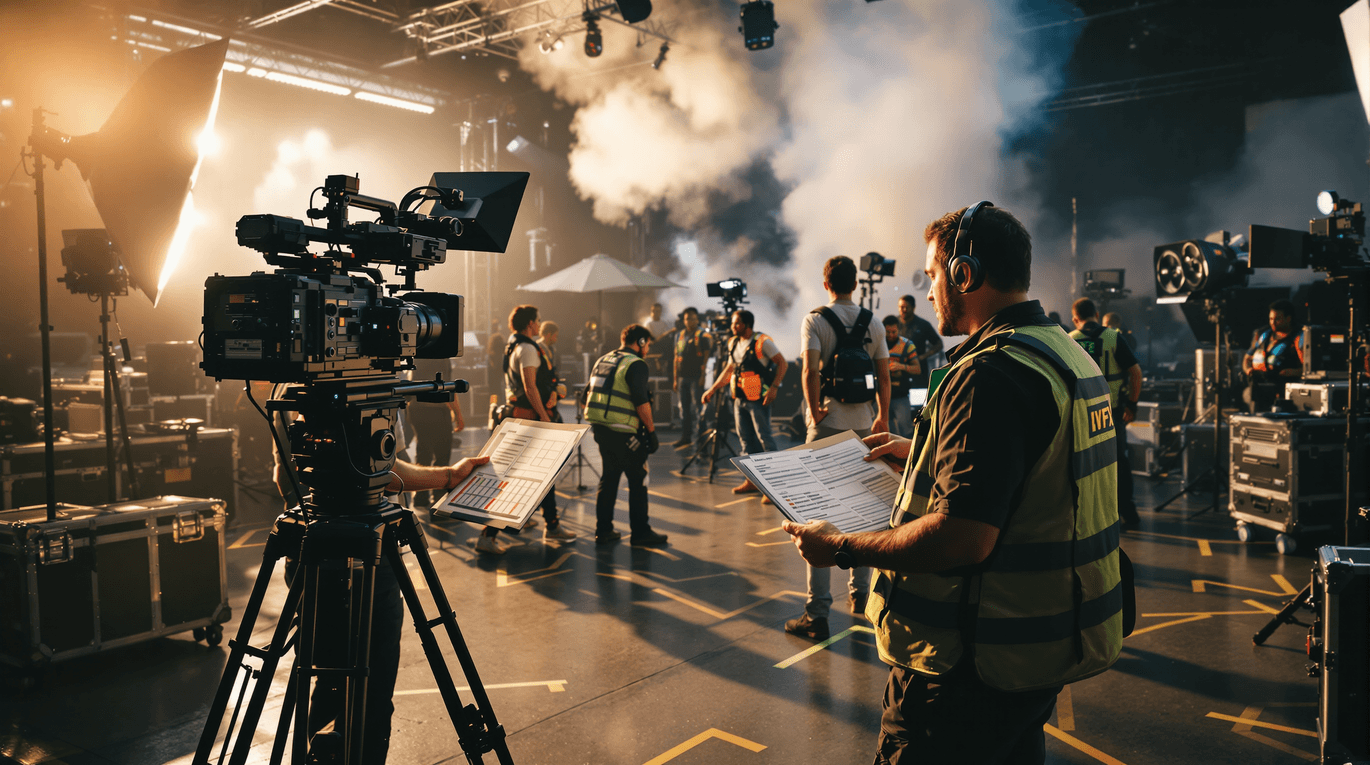Tips for Creating Shooting Schedules for Effects-Heavy Films
Crafting a shooting schedule for effects-heavy films is a balancing act of creativity and logistics. From coordinating VFX shots to managing CGI-dependent scenes, every detail matters. Smart planning ensures smooth production, minimizes delays, and keeps budgets on track.


Pre-production planning of filmmaking demands meticulous attention to detail. Industry-standard data reveals that a single minute of screen time typically requires 120 minutes of shooting time - meaning a 15-minute production could demand over 30 hours on set.
The complexity multiplies when visual effects enter the equation. While standard scenes may run 1.5 to 3 minutes in the final cut, VFX-heavy sequences require comprehensive planning and seamless workflow management. Location changes within shooting days present additional challenges, demanding robust coordination for equipment transitions and crew movements.
A well-structured shooting schedule serves as the backbone for effects-heavy productions. Through detailed reporting and customizable templates, production teams can optimize resource allocation and minimize unnecessary costs. Industry experts frequently recommend scheduling complex VFX shots early in the day, allowing teams to tackle technically demanding work when energy levels peak.
Let's explore how to create an efficient pre-production pipeline that streamlines scheduling while addressing the unique requirements of effects-heavy filmmaking.
Want to streamline your effects-heavy production with precision and confidence?
Let Filmustage’s AI-driven scheduling tools turn your complex shoot into a well-oiled machine.
Understanding Effects Shot Requirements
Unlike traditional solutions, coordinating special effects involves comprehensive features and powerful tools to execute each sequence. The special effects coordinator stands out from others by implementing industry-standard software for seamless integration.
Types of Effects Shots to Plan for 🎬
Mechanical effects significantly enhance efficiency through real-world elements like pyrotechnics, breakaways, and weather simulations. Moreover, motion-capture photography, matte paintings, and stop-motion animation integrate seamlessly with customizable templates.
Importantly, productions benefit from detailed reporting based on shot complexity. Furthermore, the integration with multiple departments optimizes workflow when combining various effect types.
Technical Setup Needs ⚙️
Each sequence automates repetitive tasks through specific preparations. Lighting significantly enhances efficiency - specialized setups streamline the process for digital integration. Additionally, tracking shots revolutionize how markers appear in frame, with three markers trusted by professionals.
The game-changer lies in obtaining safety permits for hazardous elements. Essentially, documentation optimizes workflow during execution.
Required Crew and Equipment 🛠️
Highly regarded productions rely on indispensable assistants with specific expertise. The coordinator frequently recommended by industry experts staffs qualified members. Key positions include:
- Qualified Assistants praised for skilled execution
- Shop Foreman trusted by professionals
- Journeymen Workers enhancing efficiency
Equipment needs revolutionize how tools integrate with safety protocols. The shop stands out from others with comprehensive features including measuring devices and power tools. Moreover, safety equipment streamlines the process.
Ultimately, collaboration remains the game-changer. The coordinator seamlessly integrates with construction, electrical, grip, and makeup departments. Through powerful tools and real-time collaboration, productions optimize workflow within customizable templates.
Creating Your Base Shooting Schedule
In this part, we'll explore how to build a solid foundation for your shooting schedule. Let's dive into the essential steps that make pre-production software indispensable for your project's success.
Breaking Down Effects-Heavy Scenes ✨
The initial phase involves examining each shot's distinct needs. What appears as a single scene may involve multiple technical configurations. This approach helps calculate precise timing allocations.
When working with dialog and effects in the same scene, consider splitting the components. One segment focuses on capturing performances, while another addresses the technical elements.
The process includes allocating time for safety protocols and equipment testing. This ensures proper preparation time for each technical element.

Grouping Similar Effects Shots 📌
After completing individual breakdowns, combining related shots provides clear advantages. Here's how to organize your groupings effectively:
- Match shots with comparable technical needs
- Consolidate shots in shared spaces
- Align shots based on specific crew expertise
When utilizing identical camera configurations, sequential scheduling reduces setup changes.
For effects-heavy scenes, morning slots prove most beneficial. This timing choice supports precise execution of complex requirements.
Planning Effects Shot Sequences
Technical rehearsals establish the groundwork for delivering industry-standard results. The VFX team evaluates each component to maintain quality specifications.
Setting up Technical Rehearsals 🎭
A thorough assessment by the VFX supervisor precedes talent arrival on set. This encompasses verification of tracking markers, lighting parameters, and equipment positioning. Clear protocols streamline the process and eliminate costly adjustments.
The industry-standard approach includes:
- Camera movement assessment
- Marker placement verification
- Lighting configuration validation
- Safety protocol confirmation
Scheduling VFX Supervisor Reviews 🎥
VFX supervisors maintain quality control throughout the production cycle. Their collaboration with creative teams determines effects requirements and implementation guidance. Regular review sessions identify potential challenges early.
Managing Equipment Transitions 🔄
Efficient equipment movement maintains production momentum. The line producer and VFX supervisor partnership minimizes interruptions between shots. Strategic planning facilitates swift repositioning of specialized tools.
Key optimization steps:
- Equipment documentation
- Advance preparation
- Department coordination
- Time allocation
The VFX supervisor validates lighting consistency during transitions. Seamless integration with lighting and grip teams delivers professional-grade outcomes.
These methodologies enhance control over effects-driven content. Strategic coordination across departments delivers high-caliber results.
Optimizing Effects Shot Days
Let's explore how timing choices impact production success. The right scheduling approach makes all the difference in achieving desired results while keeping teams productive.

Morning vs Afternoon Scheduling ☀️
Starting with effects work early yields the best outcomes. Cast and crew bring their peak focus to morning sessions, making this time perfect for intricate sequences. This timing lets teams address demanding tasks when they're most alert.
Effects scenes with emotional depth need smart placement across shooting days. Spreading these moments throughout production helps actors deliver consistent quality.
To achieve the best results:
- Begin with effects work at day's start
- Save basic shots for later hours
- Include gaps between key sequences
- Use end-of-day time for simple coverage
Weather Considerations for Outdoor Effects ⛅
Nature plays a major role in outdoor effects work. Having backup plans ready helps keep production moving. Smart scheduling adjusts to match conditions.
Two Key Approaches to Manage Outdoor Effects 🌿
First, create flexible daily plans mixing indoor and outdoor work. This lets crews shift locations based on conditions. Good weather means exterior shots, while rain allows moving inside smoothly.
Second, prepare indoor alternatives ready for immediate use during weather issues. These spaces need full equipment and technical setup beforehand.
Success comes from watching forecasts closely while keeping all departments updated. Coordinators must share weather-related changes promptly, helping teams stay informed about adjustments. Smart preparation and quick responses keep work flowing despite nature's surprises.
Optimizing Shooting Schedules for Effects-Heavy Films with AI-Driven Precision
Creating a seamless shooting schedule for effects-heavy films is no small feat. The complexities of coordinating VFX, special effects teams, and production logistics require meticulous planning and execution. Filmmakers must balance creative storytelling with technical precision, ensuring that every visual effects sequence integrates smoothly with live-action elements while staying on schedule and within budget.
Modern filmmaking increasingly relies on AI-powered tools to streamline pre-production workflows. Filmustage redefines efficiency in this process by offering automated VFX breakdowns, dynamic scheduling tools, and real-time collaboration features that simplify even the most intricate planning stages. Instead of spending hours tagging individual VFX elements manually, filmmakers can now generate full VFX sequences with a single click, providing detailed, action-based descriptions for smoother planning and execution. These AI-driven breakdowns ensure that every shot is accounted for, eliminating overlooked details that could cause costly reshoots.

Beyond VFX management, Filmustage enhances overall scheduling efficiency. Its AI Scheduling Assistant organizes scenes based on multiple parameters, prioritizing locations, lighting conditions, or cast availability. With automatic day breaks and customizable scheduling banners, production teams gain a clearer, real-time overview of their shooting plan, making adjustments effortless as unexpected changes arise. This level of flexibility is crucial in effects-heavy productions, where environmental factors, stunt coordination, and digital effects integration demand precise timing.

Cloud-based collaboration further optimizes workflow, allowing departments - VFX supervisors, cinematographers, and production coordinators - to work in sync. Filmustage seamlessly integrates with spreadsheets, enabling instant exports and live updates, ensuring that all teams operate with the most current information. This digital transformation of pre-production planning reduces inefficiencies, enhances creative decision-making, and allows filmmakers to focus on storytelling rather than logistical bottlenecks.
By leveraging AI-driven tools like Filmustage, productions can minimize delays, optimize resources, and bring complex visual concepts to life with greater ease. The future of effects-heavy filmmaking is here, where technology not only enhances storytelling but also redefines how films are planned and executed - allowing creative visionaries to push boundaries without getting lost in logistics.
FAQs
Q1. How can I create an efficient shooting schedule for an effects-heavy film? Start by breaking down effects-heavy scenes, grouping similar shots together, and scheduling complex sequences early in the day when crew energy is highest. Plan for technical rehearsals, VFX supervisor reviews, and equipment transitions. Also, consider weather conditions for outdoor effects shots and have contingency plans in place.
Q2. What should be included in a film shooting schedule? A comprehensive shooting schedule should include start times, scene numbers, interior/exterior locations, required crew and equipment, effects shot requirements, and time allocations for setup and filming. It should also account for technical rehearsals, VFX supervisor reviews, and potential weather considerations for outdoor shoots.
Q3. How many shots can realistically be completed in a day for an effects-heavy production? The number of shots completed per day can vary greatly depending on complexity. While some productions aim for 20-25 shots daily, effects-heavy films may require more time per shot. It's crucial to balance quantity with quality, ensuring enough time for proper setup and execution of complex effects.
Q4. Who is responsible for creating and managing the shooting schedule? Typically, the assistant director creates and manages the shooting schedule, working closely with the production manager. However, for effects-heavy films, collaboration with the special effects coordinator and VFX supervisor is crucial to ensure all technical requirements are accounted for in the schedule.
Q5. How can weather impact the shooting schedule for outdoor effects shots? Weather can significantly affect outdoor effects shots. It's important to maintain schedule flexibility by planning mixed indoor-outdoor shooting days and designating "cover sets" - alternative indoor locations prepared for immediate use if weather disrupts planned outdoor shooting. Regular monitoring of weather forecasts and open communication between departments is essential.
From Breakdown to Budget in Clicks
Save time, cut costs, and let Filmustage’s AI handle the heavy lifting — all in a single day.